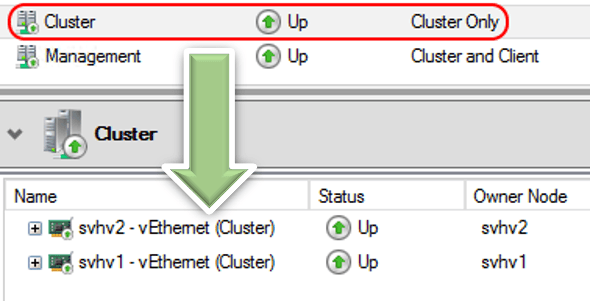Q: How many networks should I employ for my clustered Hyper-V Hosts?
A: At least two, architected for redundancy, not services.
This answer serves as a quick counter to oft-repeated cluster advice from the 2008/2008 R2 era. Many things have changed since then and architecture needs to keep up. It assumes that you already know how to configure networks for failover clustering.
In this context, “networks” means “IP networks”. Microsoft Failover Cluster defines and segregates networks by their subnets:

Why the Minimum of Two?
Using two or more networks grants multiple benefits:
- The cluster automatically bypasses some problems in IP networks, preventing any one problem from bringing the entire cluster down
- External: a logical network failure that breaks IP communication
- Internal: a Live Migration that chokes out heartbeat information, causing nodes to exit the cluster
- An administrator can manually exclude a network to bypass problems
- If hosted by a team, the networking stack can optimize traffic more easily when given multiple IP subnets
- If necessary, traffic types can be prioritized
Your two networks must contain one “management” network (allows for cluster and client connections). All other networks beyond the first should either allow cluster communications only or prevent all cluster communications (ex: iSCSI). A Hyper-V cluster does not need more than one management network.
How Many Total?
You will need to make architectural decisions to arrive at the exact number of networks appropriate for your system. Tips:
- Do not use services as a deciding point. For instance, do not build a dedicated Live Migration or CSV network. Let the system balance traffic.
- In some rare instances, you may have network congestion that necessitates segregation. For example, heavy Live Migration traffic over few gigabit adapters. In that case, create a dedicated Live Migration network and employ Hyper-V QoS to limit its bandwidth usage
- Do take physical pathways into account. If you have four physical network adapters in a team that hosts your cluster networks, then create four cluster networks.
- Avoid complicated network builds. I see people trying to make sense out of things like 6 teams and two Hyper-V switches on 8x gigabit adapters with 4x 10-gigabit adapters. You will create a micro-management nightmare situation without benefit. If you have any 10-gigabit, just stop using the gigabit. Preferably, converge onto one team and one Hyper-V switch. Let the system balance traffic.
Do you have a question for Eric?
Ask your question in the comments section below and we may feature it in the next “Quick Tip” blog post!








